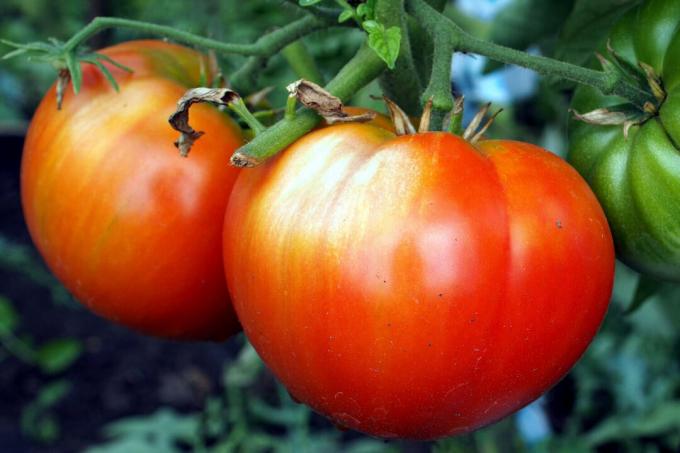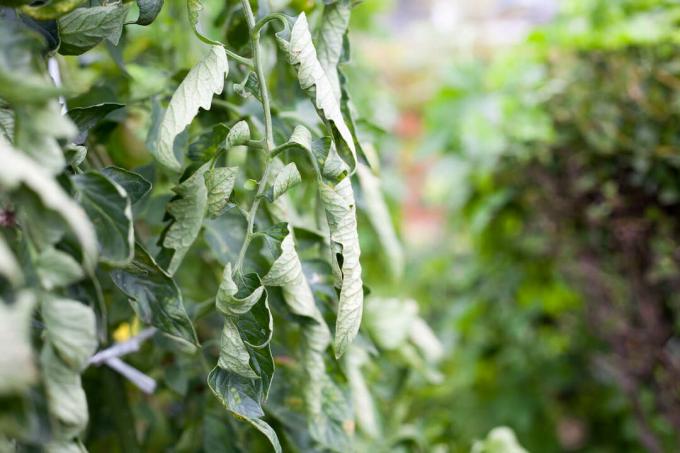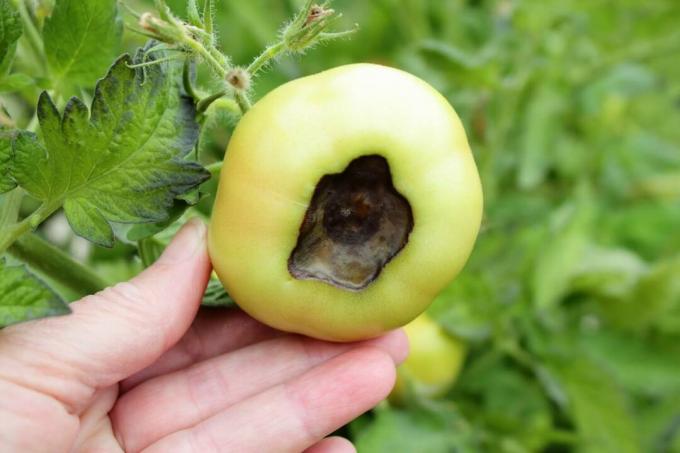Damage to tomatoes is not always caused by pathogens. We present environmental and physiological disorders in tomato plants and give tips on how to avoid them.

Not just different Tomato pests and diseases can cause damage to tomato plants and their fruits. In this article we explain common physiological damage and deformations that mostly occur during the summer and how they can be prevented.
contents
- Tomato leaves roll up
- Tomatoes burst
- Green collar on tomatoes
- Blossom end rot on tomatoes
- More tomato damage
Tomato leaves roll up
If the leaves of the tomato plant curl up, it is often due to the care measures. If the leaves roll up in the summit area, the cause is usually a lack of water. The leaf rolling of the tomato on the bottom leaves, on the other hand, occurs after the side shoots and leaves have been severely pruned. This creates a build-up of nutrients in the lower shoots that are still present. As a result, the tomato rolls up its leaves, but this does not affect the yield or the taste of the fruit.
tip: If the leaves of young tomato plants curl up, in most cases this is due to a lack of water supply or a Aphid infestationwhich can lead to deformation of young leaves and also to curling. However, a viral disease such as the Curly Top Virus is also possible. Viruses are transmitted via sucking insects and cause irreversible growth disorders in the entire plant. Affected plants should be completely disposed of.

Tomatoes burst
Ripping open tomato fruits is a common harm, but why do tomatoes burst? The main cause is a fluctuating water supply and excessive pruning or pruning. The ring-shaped bursting occurs when there is an excessive amount of water and, at the same time, cool weather. By the way, the tendency of tomatoes to burst also depends on the variety. Particularly Field tomatoes with changing humidity due to rain and drought should be burst-proof. Most fruits will scar after being torn open and are safe to eat. It becomes problematic when fungal diseases penetrate the open wound and lead to mold and rot. Dispose of infected fruits immediately.

Green collar on tomatoes
Yellow or green collars on tomatoes are usually understood to mean tissue that remains hard and does not discolour when ripe around the base of the stem. If the temperature of the fruit is too high due to direct sunlight, as well as excessive stripping, potassium deficiency and nitrogen over-fertilization, this physiological disease can result. But here too, the choice of variety is crucial. Beefsteak tomatoes and dark varieties in particular tend to have green collars, including well-known varieties such as ‘Brandywine‘, ‘Black Plum‘Or the‘Blacks from the Crimea‘. If the tissue around the stem has hardened, it should be removed before consumption. However, the rest of the fruit is completely edible.

Blossom end rot on tomatoes
Fruit or blossom end rot is a dreaded physiological disorder in which the tissue at the bottom of the fruit turns black, sinks in and hardens. The cause is a severe lack of calcium, whereupon the tissue collapses due to a lack of stability. The stains can be prevented with a sufficient supply of calcium, adding lime for planting and again as needed between June and August can prevent the often inedible fruits. You can find out more about the Blossom end rot in tomatoes.

More tomato damage
In addition to the growth and development disorders mentioned, there are also rarer disorders:
- sunburn: If the plants are not used to strong sunlight, the leaves and fruits can get sunburned. This is shown by the formation of paper changes in the tissue that appear to be transparent; the fruit underneath is often watery and soft. Severely burned leaves fall off prematurely. Slowly getting young plants used to the sun and shading the fruit effectively prevents sunburn on tomatoes.
- Oat and barley blossom: In poor lighting conditions, too cold temperatures and high humidity, oat or Barley flowers on. In the oat blossom, the pale yellow sepals grow excessively long and do not roll back. The barley blossom, on the other hand, is short and thick, pollen and stigma are poorly developed. This results in fertilization disorders with little yield and many shed flowers.
- Indoor tan: As a result of excessive evaporation, brown, dried-up tissue forms inside the tomato fruit. Heat and dry air are problematic. Indoor tanning occurs especially after heavy watering and simultaneous potassium deficiency.
- Water sickness: If the fruit does not discolour in places when ripe and shows brown veins inside, it is referred to as water sickness. Even watering and a good supply of potassium prevent this.
tip: A balanced supply of nutrients can prevent many physiological disorders. An organic liquid fertilizer like ours Plantura organic tomato & vegetable fertilizer can be easily dosed and applied via the irrigation water. The increased potassium content promotes the fruit development of tomatoes and numerous other vegetables.
- Fertility disorders: In addition to the oat and barley blossoms, suboptimal conditions can also lead to fertilization disorders. Extremely high or low humidity, temperatures above 30 ° C, lack of water and a lack of pollinators (Insects or wind movement) can lead to insufficient pollination and thus to flower fall and low yield to lead.
- Fruit malformations: Genetically determined, fruit can have appendages, also known as "noses", which usually change color before the main fruit. Strongly ribbed and overgrown fruits can also occur. You shouldn't use any of these fruits Gaining tomato seeds, however, they are completely edible and often an eye-catcher in the garden.

In addition to environmental disturbances, numerous bacterial and viral pathogens and fungi can also damage tomatoes. We give tips on how to make your Protect tomatoes from disease can.



